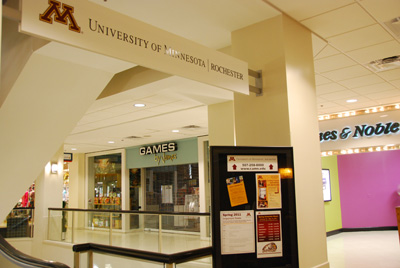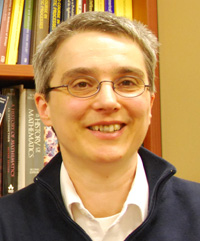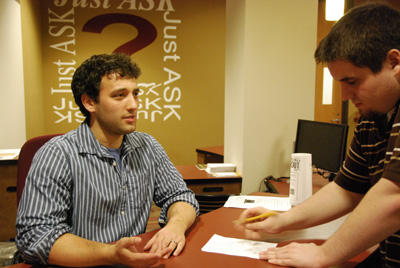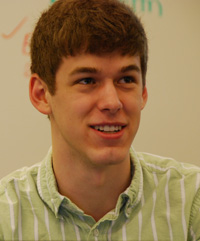There are many reasons professors who lecture don't want to give it up. Tradition may be the mightiest force.
"Lecturing is just the way a lot of professors have always done it," says Joe Redish, a physicist at the University of Maryland, College Park who has done research on why lectures aren't effective.
"A lot of [them] are not excited about the idea that they might have to move out of their comfort zone," he says. Plus, professors are under pressure to publish.
"Your research matters," Redish says. "Your teaching you can get by with."
This is the message Redish got from his department when he started teaching in 1970, and he says it's still the message young faculty get today.
"Until the perception of the quality of a department begins to depend on how innovative and creative it is in teaching," he says, there's not going to be much incentive for professors to try new approaches.
Even at liberal arts colleges where teaching is more of a focus, professors are under pressure to produce research.
"You risk your tenure as an early-career professor if you focus too much on teaching, even at our teaching-centered institutions," says Julie Schell, an education researcher at Harvard University who wrote her dissertation on why the lecture continues to be a dominant approach.
Schell says another reason professors stick with traditional approaches is they don't know
much about alternatives. Few get training or coaching on how to teach.
"It's kind of ironic that we as professors don't have any type of training in any way, shape or form," says Andy Petzold. "It's the only teaching degree that you don't need to go through any actual training in teaching to do."
Petzold, who recently finished his Ph.D. in biology, is one of 14 faculty members at the University of Minnesota Rochester, a brand new campus that opened in the fall of 2009. Petzold came to UMR because it offers him a unique chance to learn about teaching at a place where a lot of things about how traditional colleges work are being turned upside down.
A Clean Slate
The chancellor of the University of Minnesota Rochester is Stephen Lehmkuhle, a former administrator at the University of Missouri and a psychologist who spent much of his career studying how the brain processes information. He says advances in cognitive science over the past 30 years lead him to believe that colleges should radically rethink the way they deliver education. But universities are stubborn places where tradition and politics make it extremely difficult to make substantial changes in the way things are done.
"You spend a lot of energy just to create space for innovation," he says. You might make progress with one innovation, but people are so set in their ways that "you turn your back and [the innovation] just gets sucked up as though it's a foreign body."
Lehmkuhle needed a clean slate to make the changes he had in mind.
So when the University of Minnesota decided to create a new campus in Rochester, he applied for the chancellor's job. The university wanted a school that would prepare students for careers in health sciences and take advantage of proximity to the city's renowned Mayo Clinic. Lehmkuhle thought that was a good idea. But he told the search committee he wanted to create a totally new kind of college at the same time — a college based on what researchers have come to understand about how people learn.
"What we decided here is that we're going to build an institution that's focused on learning," he says. "We want them to learn through understanding, not to memorize to learn."
A New Kind of College
There are no lecture halls at the University of Minnesota Rochester. There are also no fraternities, no football team, not even a library — everything is online. If you want a book you can order it from one of the other U of M campuses, but only professors request them. Students get all the information they need through their laptops. There are about 100 freshmen and 35 sophomores. The plan is to expand the size of the class each year until there are about 1,000 students.
UMR does have a campus. To get there you enter a downtown shopping mall and take an elevator up. Most of the campus fits into the top two floors of the mall, where a food court and a movie theater used to be. The space has been renovated into offices, a commons area, a tutoring center and state-of-the-art classrooms.
UMR takes classroom design seriously. There is no "front of the room" as there is in a typical lecture hall.
"We removed the front so that we would move away from having one authority who disseminates knowledge," says vice chancellor Claudia Neuhauser. The goal is to put the focus "much more on the students," she says.
To see this philosophy in action, I visit a biology class. It starts with an assignment. The students have to write a multiple choice question based on the material they've been learning.
"You know you understand something when you can teach somebody else," says the professor, Kesley Metzger. "So if a student can't write a question, then it gives them an idea that they don't fully understand the material."
The students work in small groups to write the questions. All the furniture is on wheels to allow students to work together like this. Each group has a portable dry-erase board that students use to compose their questions. When they're done, they hang their boards on the wall so the rest of the class can see.
There are cameras hanging from the ceiling so that students can take snapshots of what they wrote on their boards and save the information on their laptops for future reference. There are also screens across each corner of the room so that the professor can project slides from her laptop and everyone can see, no matter where they are sitting.
Professor Metzger stops the class at various points to give explanations of certain topics or ideas, but for most of the class the students are doing the talking, responding to assignments designed to get them thinking and talking about the material they are learning.
All of the classes at UMR are designed to work like this.
"There may be a brief lecture at the beginning," says chancellor Lehmkuhle, "but then [students] are given problems and they're working on things together as teams."
(To hear more about how students at UMR work in teams, listen to ARW's Aug. 19, 2011, podcast: Group Learning.)
This approach works when students come to class prepared by having read the assigned portions of the textbook, says professor Metzger.
It's not that they're expected to understand everything they've read, she says, "but we expect them to have looked over the material so that when they come to class we can use that time not just to introduce the terminology but to actually engage at a deeper level so that they can explore what those things mean [and] they can think critically about ideas."
Metzger circulates around the room throughout class, answering questions and probing students' understanding. She's assisted by her co-instructor Andy Petzold. There are 48 students, and the instructors get to all of them during the hour and 40 minute class. Chancellor Lehmkuhle says this model is designed to work in classes with up to 100 students and he expects some classes at UMR will eventually be that size.
"It's not the size of the class, it's the contact with the students. That's what we're paying attention to," he says. "You could have a class with 10 students and if the faculty member just lectures and doesn't really interact with you very much it's not any different than if you were in a class of 200 students. It's how interactive you can make the environment."
"The Secret Sauce"
The fact that people learn better when they're actively engaged is one of the central findings of cognitive research conducted over the past few decades. Another finding, one that may seem obvious, is that people learn when they're motivated to learn.
"The secret sauce" is if instructors can get students excited about what they're learning, we can take 'em places," says Lehmkuhle. The key to motivating students is to help them make connections between what they're learning and what they already know and are interested in.
"When you read about learning and the neuroscience or cognitive science of learning, it's all about making connections," says Lehmkuhle. "And so that was really the basis for everything that we did here - to help students make connections."
One way UMR is helping students make connections is by actually connecting their classes. Students in the biology class I visited also take the same ethics class and the same writing class. In biology they're learning about stem cells and genetics. In ethics they're digging into philosophical questions related to genetic technologies. And in writing class they're working on essays about how their views on genetic technologies have changed.
Lehmkuhle says integrating the curriculum like this allows students to see links between information and ideas they are learning in different subject areas. At traditional universities, he says, students and faculty tend to see education as a collection of isolated courses. He thinks colleges need to start thinking about education not as the pursuit of knowledge in distinct disciplines, but as the acquisition of skills necessary to succeed in a world where knowledge is constantly changing.
"Knowledge is changing so rapidly that what we teach 'em today is going to be outdated three years from now," he says. "It doesn't make any sense for us to teach them things that they're not going to be able to use by the time they get out into the field."
For Lehmkuhle, the central problem with the traditional lecture is that it puts so much emphasis on facts and information. He says while there may have been a time when "being educated" meant mastering a certain amount of material, that's not the case anymore.
"You really have to teach them to learn how to learn," he says.
A New Way of Doing Things
UMR is not just experimenting with the way classes are taught; faculty and administrators are experimenting with the way colleges are set up.
There are no departments at UMR. Biologists, sociologists and chemists all work together in one department called the Center of Learning Innovation.
"All our faculty sit around the same table and design the curriculum," says Lehmkuhle. "So you have [a] philosopher sitting across the table from a biologist, a chemist sitting across the table from a literature person and so on."
There are also two types of professors at UMR. One group's only responsibility is to work with students; they're called "student-based" faculty and they're not expected to do any research.
Andy Petzold is a student-based faculty member. When he's not teaching classes, he works in UMR's tutoring center, which is like a walk-in clinic where students can get help at any time during the day. Petzold says he may eventually pursue a more traditional faculty position, but this job is an opportunity to learn about teaching that he wouldn't get at other universities.
The other group of professors is called "learning design" faculty. They are expected to do research not just in their discipline but in education as well.
"They're actually tenured and promoted on their ability to do research on the learning of their students," says chancellor Lehmkuhle.
That means for example that a biologist has to do research on how people learn - not something biologists traditionally do. But UMR is all about breaking traditions. Perhaps not surprisingly, almost all of the professors here are relatively young; it's their first or second job out of graduate school. They came to UMR because they want to be part of a new way of doing things.
The students come here for the same reason.
"We are giant guinea pigs in this huge experiment," says freshman Tim Horn. He's excited about learning in new ways, and thinks it's working for him.
Chancellor Lehmkuhle says it will be many years before UMR can determine if its model is successful. In the short term, he'll be looking at things like graduate school admissions and job placement rates among UMR's graduates. In the longer run, he'll be looking at the research his faculty generates about learning.
"I think we have a responsibility to the rest of higher education to try new things and to push the limit," he says. "We do have this freedom that they don't have."












